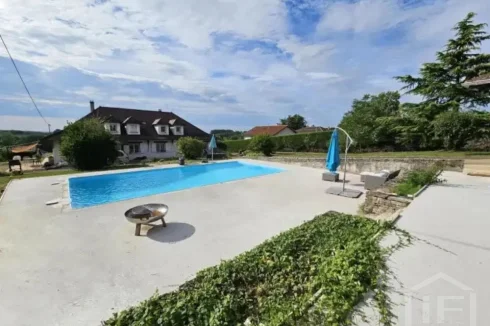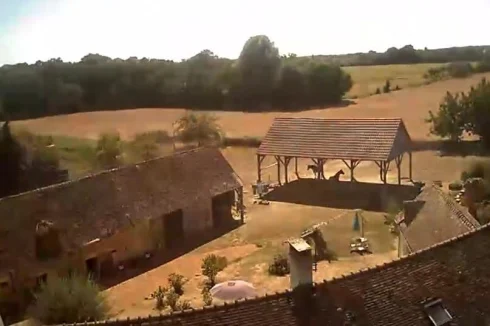Creating a Building Plot on Your Property
Tuesday 05 November 2013
How to go about dividing up land on your property and obtaining planning permission to create a building plot.
One of the distinguishing features of many properties in France is the amount of land that frequently comes with even a modestly priced rural property.
Those who seek land with property rarely do so with the aim of then installing an immediate neighbour on their doorstep.
Arthur Cutler of planning consultancy French Plans states: "Indeed, unless the area is zoned for new construction, planning regulations in the countryside would normally preclude new construction other than additions to an existing property, which may also be limited in size."
Nevertheless, edge of village properties and those in hamlets frequently offer the opportunity for a division of land to take place in order for a building plot to be created.
Owners then have the option of simply selling off the building plot to realise a capital gain, or selling off both their existing home and the building plot as separate lots.
Whether the latter operation would be financially advantageous would obviously depend on the circumstances of the case.
Planning Regulations
Clearly, the viability of such an idea will depend on the local planning regulations and any restrictions as regards the division of the property.
Local planning regulations may positively encourage the division of existing properties, but others are based upon a less generous view, frequently because of a lack of suitable infrastructure, eg electricity supply, sanitation.
Others have conditions which impose a minimum size of building plots (minimum parcellaire), which are frequently around 2000m², although smaller in more urbanised areas. These minimum surface areas are used to protect the countryside and to provide an appropriate surface area for a private sewage system.
In the absence of any detailed planning regulations, the view of the local mayor will be important.
So perhaps the first approach if you intend to pursue the idea is to have a word with your local mayor on the generalities of the proposal.
If the regulations permit new construction, then would probably be the time to organise professional assistance.
Land Surveyor
Your second port of call might then best be a local land surveyor (géomètre) whose assistance will be required for the formal division of the land. They might also be able to offer more general support and advice in relation to services.
The géomètre is the only person legally entitled to determine definitively the boundary between two properties.
The process of doing so is called ‘bornage’.
You are likely to need the involvement of your neighbour(s), as the boundaries on all sides of the plot will need to be fixed by the géomètre, not merely the boundary with your own property.
The new division of boundaries will then need to be registered with the land registry, with the formalities of the registration undertaken via a notaire.
No sale of the land can be undertaken until this registration process has taken place, although the two can be undertaken simultaneously.
Déclaration Préalable
Having undertaken the division of land is only the first stage of the process, for it is also necessary to submit a formal application to the local council (mairie) for the division of the land for building purposes.
This application is called a déclaration préalable although where more than two building plots are to be created then a permis d’aménagement is necessary.
There are also other circumstances when a permis d’aménagement is necessary, so professional planning or architectural advice will need to be taken for this process.
If there is no opposition to the déclaration préalable within one month, then the consent is said to have been implicitly granted (tacit approval), although it is possible to ask for a certificate of non-opposition à déclaration préalable.
"However", says Arthur Cutler, "the process does not force the planning authority to issue formal documentation and they also retain the right to overturn a tacit approval for a period of 3 months in the event that it is judged not to conform to regulations."
Obtaining a déclaration préalable is not by itself planning consent (permis de construire), which will need to be made by the purchaser as part of the purchase process, or after the sale has taken place.
In the case of the latter then land is then normally sold with an ‘in principle’ planning consent called a certificat d’urbanisme.
Easements
It is also possible to control the nature of the development that takes place on the building plot through the imposition of easements contained in the sale contract.
These easements (servitudes non aedificandi) can impose constraints for instance on the size or height of the dwelling, or proximity to your property.
Regulations may also exist as to the dimensions of any new construction and the distance from the boundaries of the plot, and it is important to check these prior to preparing a full planning application.
Of course, the tougher the easements you impose the lower is likely to be the ultimate sale value of the property.
Taxes
The taxation of capital gains on new building land has been toughened considerably in recent years, and several taxes are potentially payable.
The system of taxation is complex and in the process of change. Professional advice from a good notaire or tax advisor is necessary.
You can read more in Captial Gains Tax on Building Land.
Next Article: Unviversity Grants and Loans in France
Thank you for showing an interest in our News section.
Our News section is no longer being published although our catalogue of articles remains in place.
If you found our News useful, please have a look at France Insider, our subscription based News service with in-depth analysis, or our authoritative Guides to France.
If you require advice and assistance with the purchase of French property and moving to France, then take a look at the France Insider Property Clinic.





